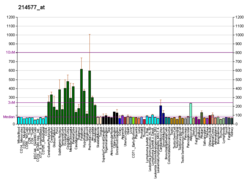Microtubule-associated protein 1B is a protein that in humans is encoded by the MAP1B gene.
Function
This gene encodes a protein that belongs to the microtubule-associated protein family. The proteins of this family are thought to be involved in microtubule assembly, which is an essential step in neurogenesis. The product of this gene is a precursor polypeptide that presumably undergoes proteolytic processing to generate the final MAP1B heavy chain and LC1 light chain. Gene knockout studies of the mouse microtubule-associated protein 1B gene suggested an important role in development and function of the nervous system. Two alternatively spliced transcript variants have been described.
Interactions
MAP1B has been shown to interact with Acidic leucine-rich nuclear phosphoprotein 32 family member A and RASSF1.
References
- ^ GRCh38: Ensembl release 89: ENSG00000131711 – Ensembl, May 2017
- ^ GRCm38: Ensembl release 89: ENSMUSG00000052727 – Ensembl, May 2017
- "Human PubMed Reference:". National Center for Biotechnology Information, U.S. National Library of Medicine.
- "Mouse PubMed Reference:". National Center for Biotechnology Information, U.S. National Library of Medicine.
- Lien LL, Boyce FM, Kleyn P, Brzustowicz LM, Menninger J, Ward DC, Gilliam TC, Kunkel LM (Oct 1991). "Mapping of human microtubule-associated protein 1B in proximity to the spinal muscular atrophy locus at 5q13". Proc. Natl. Acad. Sci. U.S.A. 88 (17): 7873–6. Bibcode:1991PNAS...88.7873L. doi:10.1073/pnas.88.17.7873. PMC 52406. PMID 1881920.
- ^ "Entrez Gene: MAP1B microtubule-associated protein 1B".
- Opal P, Garcia JJ, Propst F, Matilla A, Orr HT, Zoghbi HY (Sep 2003). "Mapmodulin/leucine-rich acidic nuclear protein binds the light chain of microtubule-associated protein 1B and modulates neuritogenesis". J. Biol. Chem. 278 (36): 34691–9. doi:10.1074/jbc.M302785200. PMID 12807913.
- Dallol A, Agathanggelou A, Fenton SL, Ahmed-Choudhury J, Hesson L, Vos MD, Clark GJ, Downward J, Maher ER, Latif F (Jun 2004). "RASSF1A interacts with microtubule-associated proteins and modulates microtubule dynamics". Cancer Res. 64 (12): 4112–6. doi:10.1158/0008-5472.CAN-04-0267. PMID 15205320.
Further reading
- Hammarback JA, Obar RA, Hughes SM, Vallee RB (1991). "MAP1B is encoded as a polyprotein that is processed to form a complex N-terminal microtubule-binding domain". Neuron. 7 (1): 129–39. doi:10.1016/0896-6273(91)90081-A. PMID 1712602. S2CID 34690111.
- Schoenfeld TA, McKerracher L, Obar R, Vallee RB (1989). "MAP 1A and MAP 1B are structurally related microtubule associated proteins with distinct developmental patterns in the CNS". J. Neurosci. 9 (5): 1712–30. doi:10.1523/JNEUROSCI.09-05-01712.1989. PMC 6569839. PMID 2470876.
- Avila J, Ulloa L, Diez-Guerra J, Diaz-Nido J (1994). "Role of phosphorylated MAPlB in neuritogenesis". Cell Biol. Int. 18 (5): 309–14. doi:10.1006/cbir.1994.1079. PMID 7519512. S2CID 85789590.
- Lien LL, Feener CA, Fischbach N, Kunkel LM (1994). "Cloning of human microtubule-associated protein 1B and the identification of a related gene on chromosome 15". Genomics. 22 (2): 273–80. doi:10.1006/geno.1994.1384. PMID 7806212.
- Ohyu J, Takashima S (1998). "Decreased expression of microtubule-associated protein 5 (MAP5) in the molecular layer of cerebellum in preterm infants with olivocerebellar lesions". Brain Dev. 20 (1): 22–6. doi:10.1016/S0387-7604(97)00088-0. PMID 9533556. S2CID 20265712.
- Lucas FR, Goold RG, Gordon-Weeks PR, Salinas PC (1998). "Inhibition of GSK-3beta leading to the loss of phosphorylated MAP-1B is an early event in axonal remodelling induced by WNT-7a or lithium". J. Cell Sci. 111 ( Pt 10) (10): 1351–61. doi:10.1242/jcs.111.10.1351. PMID 9570753.
- Tögel M, Wiche G, Propst F (1998). "Novel features of the light chain of microtubule-associated protein MAP1B: microtubule stabilization, self interaction, actin filament binding, and regulation by the heavy chain". J. Cell Biol. 143 (3): 695–707. doi:10.1083/jcb.143.3.695. PMC 2148156. PMID 9813091.
- Hanley JG, Koulen P, Bedford F, Gordon-Weeks PR, Moss SJ (1999). "The protein MAP-1B links GABA(C) receptors to the cytoskeleton at retinal synapses". Nature. 397 (6714): 66–9. Bibcode:1999Natur.397...66H. doi:10.1038/16258. PMID 9892354. S2CID 4421437.
- Jensen PH, Islam K, Kenney J, Nielsen MS, Power J, Gai WP (2000). "Microtubule-associated protein 1B is a component of cortical Lewy bodies and binds alpha-synuclein filaments". J. Biol. Chem. 275 (28): 21500–7. doi:10.1074/jbc.M000099200. PMID 10764738.
- Tanner SL, Franzen R, Jaffe H, Quarles RH (2000). "Evidence for expression of some microtubule-associated protein 1B in neurons as a plasma membrane glycoprotein". J. Neurochem. 75 (2): 553–62. doi:10.1046/j.1471-4159.2000.0750553.x. PMID 10899930. S2CID 33325478.
- Mei X, Sweatt AJ, Hammarback JA (2000). "Regulation of microtubule-associated protein 1B (MAP1B) subunit composition". J. Neurosci. Res. 62 (1): 56–64. doi:10.1002/1097-4547(20001001)62:1<56::AID-JNR6>3.0.CO;2-#. PMID 11002287. S2CID 196600490.
- Billups D, Hanley JG, Orme M, Attwell D, Moss SJ (2000). "GABAC receptor sensitivity is modulated by interaction with MAP1B". J. Neurosci. 20 (23): 8643–50. doi:10.1523/JNEUROSCI.20-23-08643.2000. PMC 6773065. PMID 11102469.
- Franzen R, Tanner SL, Dashiell SM, Rottkamp CA, Hammer JA, Quarles RH (2001). "Microtubule-associated protein 1B: a neuronal binding partner for myelin-associated glycoprotein". J. Cell Biol. 155 (6): 893–8. doi:10.1083/jcb.200108137. PMC 2150906. PMID 11733546.
- Ding J, Liu JJ, Kowal AS, Nardine T, Bhattacharya P, Lee A, Yang Y (2002). "Microtubule-associated protein 1B: a neuronal binding partner for gigaxonin". J. Cell Biol. 158 (3): 427–33. doi:10.1083/jcb.200202055. PMC 2173828. PMID 12147674.
- Dergunova LV, Raevskaya NM, Vladychenskaya IP, Limborska SA (2003). "Hmob3 brain-specific sequence is a part of phylogenetically conserved human MAP1B gene 3'-untranslated region". Biomol. Eng. 20 (3): 91–6. doi:10.1016/S1389-0344(03)00003-0. PMID 12684070.
- Chang L, Jones Y, Ellisman MH, Goldstein LS, Karin M (2003). "JNK1 is required for maintenance of neuronal microtubules and controls phosphorylation of microtubule-associated proteins". Dev. Cell. 4 (4): 521–33. doi:10.1016/S1534-5807(03)00094-7. PMID 12689591.
- Opal P, Garcia JJ, Propst F, Matilla A, Orr HT, Zoghbi HY (2003). "Mapmodulin/leucine-rich acidic nuclear protein binds the light chain of microtubule-associated protein 1B and modulates neuritogenesis". J. Biol. Chem. 278 (36): 34691–9. doi:10.1074/jbc.M302785200. PMID 12807913.
This article on a gene on human chromosome 5 is a stub. You can help Misplaced Pages by expanding it. |




